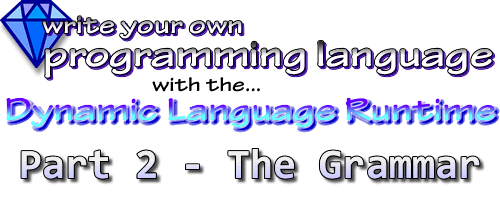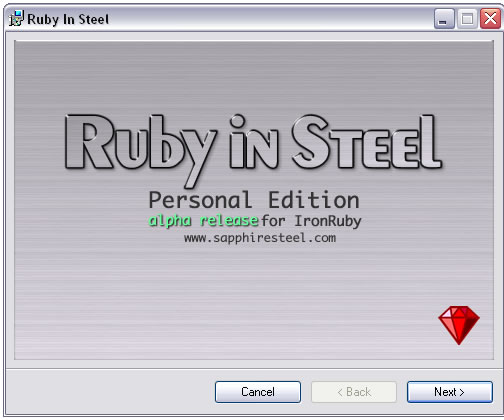Developments in Development Tools
Friday 11 April 2008
The last couple of years have seen a great many changes for CodeGear - not least the name! The company that I knew for so many years as ‘Borland’ has been reborn as a new company with a new name but it is, nonetheless, owned by the old company with the old name. Just in case you missed these developments I should explain that Borland - the company that I have always associated with developer tools - has transformed itself into a company that specialises in mysterious acronyms such as ALM (Application Lifecycle Management) and SDO (Software Delivery Optimization) - terms which, in my ignorance, I must confess mean next to nothing to me. Meanwhile, the ‘real’ Borland - the Borland that gave the world a range of fast ‘Turbo’-branded compilers and the ‘Visual Pascal’ Delphi language - has now condensed into CodeGear.
Dermot Hogan looks at what’s required to build your very own computer language using two new – and remarkable – tools. Microsoft’s Dynamic Language Runtime and ANTLR3 by Terrence Parr from the University of San Francisco.
Wednesday 2 April 2008
 In this series, I’m going to start at the bottom of the DLR pond and work upwards towards the light.Specifically, I’m going to construct an ANTLR tree grammar for a calculator and show you how to wire this into a DLR framework. This is about as simple as you can get with the DLR and still do something meaningful. It’s a lot simpler than the Microsoft example, ToyScript, which comes with the Iron Python distribution. I’ve tried hard to pare the calculator example down to the absolute minimum required to actually do something non-trivial. But I don’t want to denigrate ToyScript – it’s an excellent example of how to use the DLR, but in my view it’s not quite introductory enough.
In this series, I’m going to start at the bottom of the DLR pond and work upwards towards the light.Specifically, I’m going to construct an ANTLR tree grammar for a calculator and show you how to wire this into a DLR framework. This is about as simple as you can get with the DLR and still do something meaningful. It’s a lot simpler than the Microsoft example, ToyScript, which comes with the Iron Python distribution. I’ve tried hard to pare the calculator example down to the absolute minimum required to actually do something non-trivial. But I don’t want to denigrate ToyScript – it’s an excellent example of how to use the DLR, but in my view it’s not quite introductory enough.
Book Review
Monday 31 March 2008
The birth of a language...
Tuesday 18 March 2008
Our new series on writing a programming language is more than just a theoretical endeavour. Its author, Dermot Hogan, will, over the course of the next few months, be developing an implementing a new programming language called Sapphire. His series will explain the process in detail. It will also explain the techniques needed to create some other language of your choice to run on Microsoft’s Dynamic Language Runtime.
Problem and Fix For VS2008 WPF Apps
Monday 10 March 2008
My attempts to design a nice shiny front end to my C# applications using Microsoft’s new WPF (the rather forgettable abbreviation of the longwinded ‘Windows Presentation Foundation’ Framework), were, initially, sorely frustrated. I fired up Visual Studio 2008, started a WPF Application and tried dropping some controls onto it - no deal!
A developer’s guide to the Dynamic Language Runtime
Monday 3 March 2008

Dermot Hogan looks at what’s required to build your very own computer language using two new – and remarkable – tools: Microsoft’s Dynamic Language Runtime and ANTLR3 by Terrence Parr from the University of San Francisco.
Download and play
Thursday 28 February 2008
When not writing articles for Bitwise, I happen to be a director of SapphireSteel Software - the software company responsible for the Ruby In Steel IDE for Visual Studio.

The face of future applications development?
Monday 25 February 2008
Adobe had today released the Flex 3 framework and the FlexBuilder 3 IDE. This is an exciting development for anyone interested in creating rich interactive applications (RIA) for both the desktop and the web. A couple of days ago I spoke to Steven Heintz (senior product manager for Flex), and started out by asking him about Flex’s new AIR framework. Like, for instance, what exactly is it, anyhow...?
Programming Power - but at a price...
Sunday 24 February 2008
I just came across an interesting article called “Monkeypatching is Destroying Ruby” on a blog with the admirable name, ‘Virtuous Code’. The author, Avdi Grimm, a long-time Ruby programmer, observes that the current trend among many Ruby developers is to extend the functionality of existing code using metaprogramming. This practice is called “Monkeypatching” - a term that is new to me but seems appropriately descriptive.
Microsoft Give-away
Tuesday 19 February 2008
MS Windows Server 2003 and xna Game Studio are also free. Yes, really and truly, Microsoft is giving away the full versions of all that software for zero cost.
More online communities...
Wednesday 13 February 2008
Following my recent blog on the LiveMocha online language-learning community, I’ve now discovered a few other similar (to some degree) communities.
Learn a language online
Monday 11 February 2008
Language learning at home can be a frustrating and lonely business. Sure. you can buy course books or CD tutorials but, even so, keeping up the motivation can be hard work. I know. I’ve tried and failed far too often with far too many languages.
What, When and Where is it...?
Monday 4 February 2008

Over the last thirty years or so, computer programming has been singularly devoid of Big Ideas. We’ve seen waves of YACLL (‘Yes Another C-Like Language’) with the odd Basic or Pascal variants to please programmers with an aversion to curly brackets. Some of have been good, others less so. But none of them (that I am aware of) has had the ‘knock-your-socks-off’ factor.
updated: 9th August, 2008
Friday 1 February 2008
There are many reasons someone or some organization out in the Internet might want to penetrate your Windows computer. Here are a few examples –
The fix...
Monday 28 January 2008
In my review of the book ‘Windows Vista Annoyances’ recently, I mentioned the problems I was having when viewing MPG videos in Windows Media Player. These used to play fine. But now they just playing the video without any audio. These problems seem to have crept in since I installed Windows Vista and Windows Media Player 11.
Book Review
Tuesday 22 January 2008
 Windows Vista Annoyances - $34.99 (£21.99)
Windows Vista Annoyances - $34.99 (£21.99)
by David A. Karp
O’Reilly http://www.oreilly.com/
642 pp.
ISBN-10 0-596-52762-4
ISBN-13 978-0-596-52762-4
Interview
Monday 14 January 2008
Morfik’s WebOS AppsBuilder is an innovative product which lets you create dynamic web applications written in Java, C#, Basic or Pascal. Here Bitwise speaks to Morfik co-founder, Shahram Besharati.

...using OoRexx
Tuesday 8 January 2008

Ever have to manage users’ SQL queries? If so, you know you need some sort of automated mechanism. Sometimes you can achieve this with features built into the database, such as stored procedures or SQL queries that reside in a data dictionary. In other cases you can employ a front-end query tool for this purpose. Still another option is to build your own interface.
Ruby In Steel Text Edition
Monday 7 January 2008
As I mentioned in my last blog post, while other people were spending a relaxing Christmas and New Year, I was hard at work getting the new version of our Ruby On Rails IDE ready for launch. Well, it launched today. It’s called Ruby In Steel Text Edition and it comes complete with its own copy of Visual Studio 2008 at no extra cost.

...normal service will be resumed as soon as possible.
Thursday 3 January 2008
It’s been a busy holiday period for us. First of all we moved the entire Bitwise site - articles, databases, content management system et al - from one server to another. And, as if that wasn’t enough to be doing, my software company has also been working on a new release (which we will announce on our site next week).
More..
|
|
|
|
|
300
|
|
|
|
|